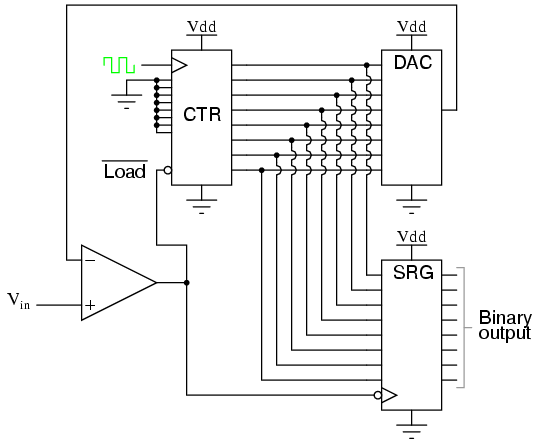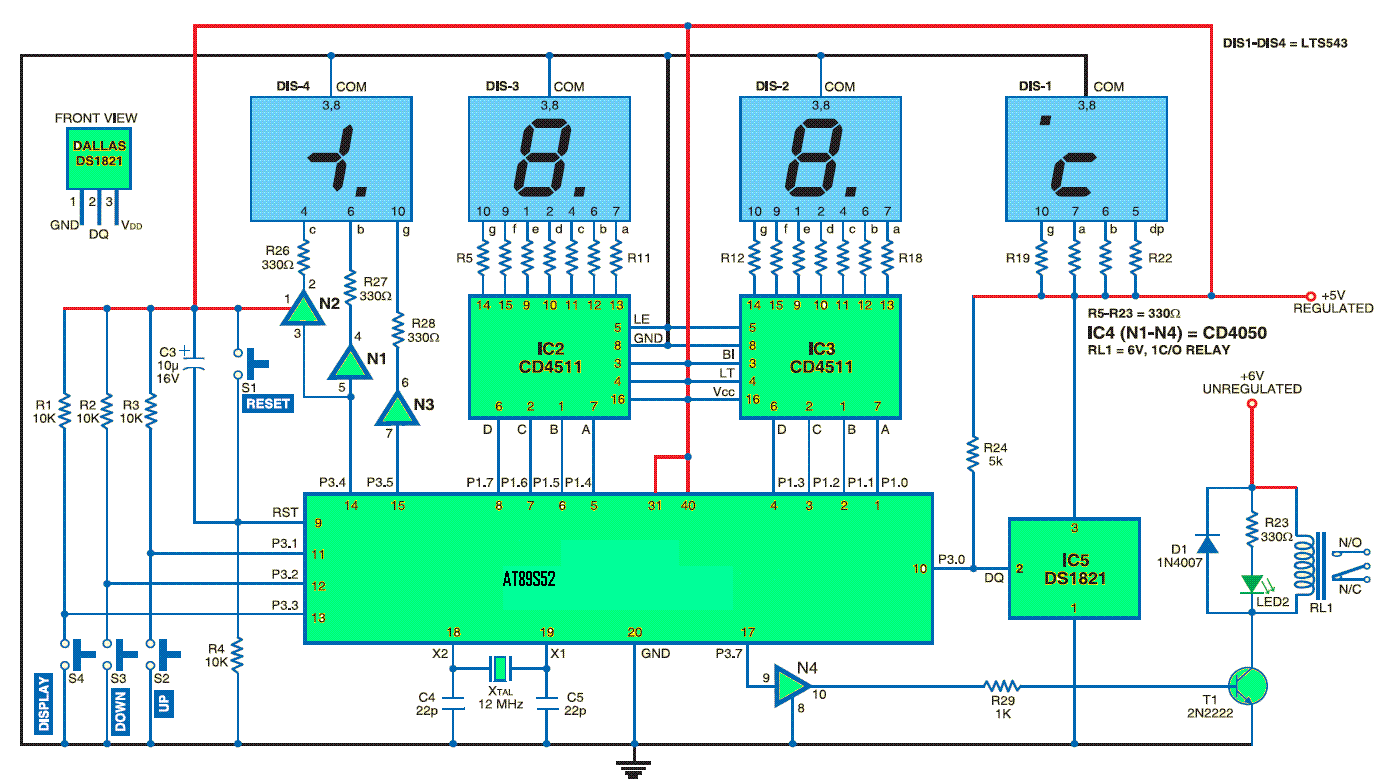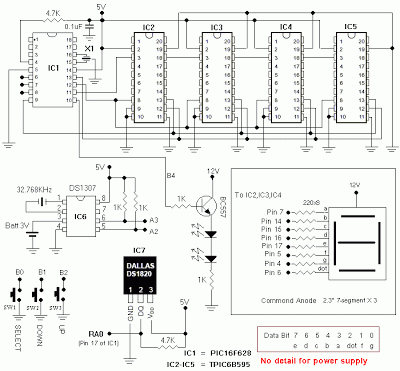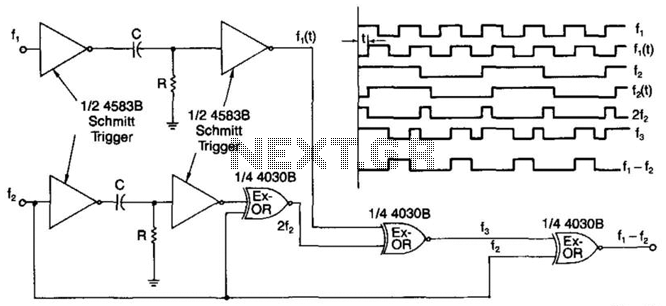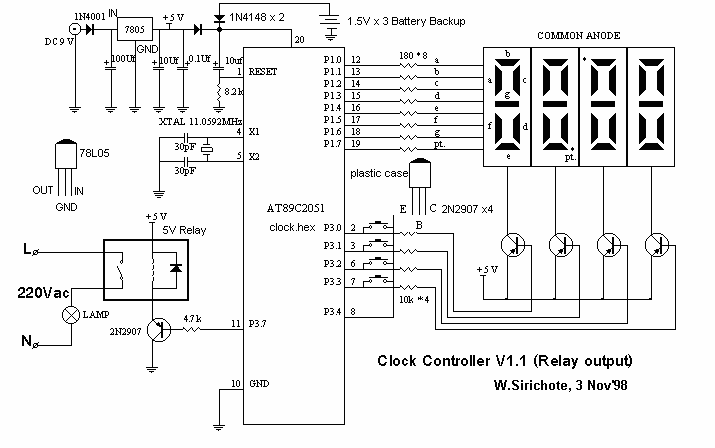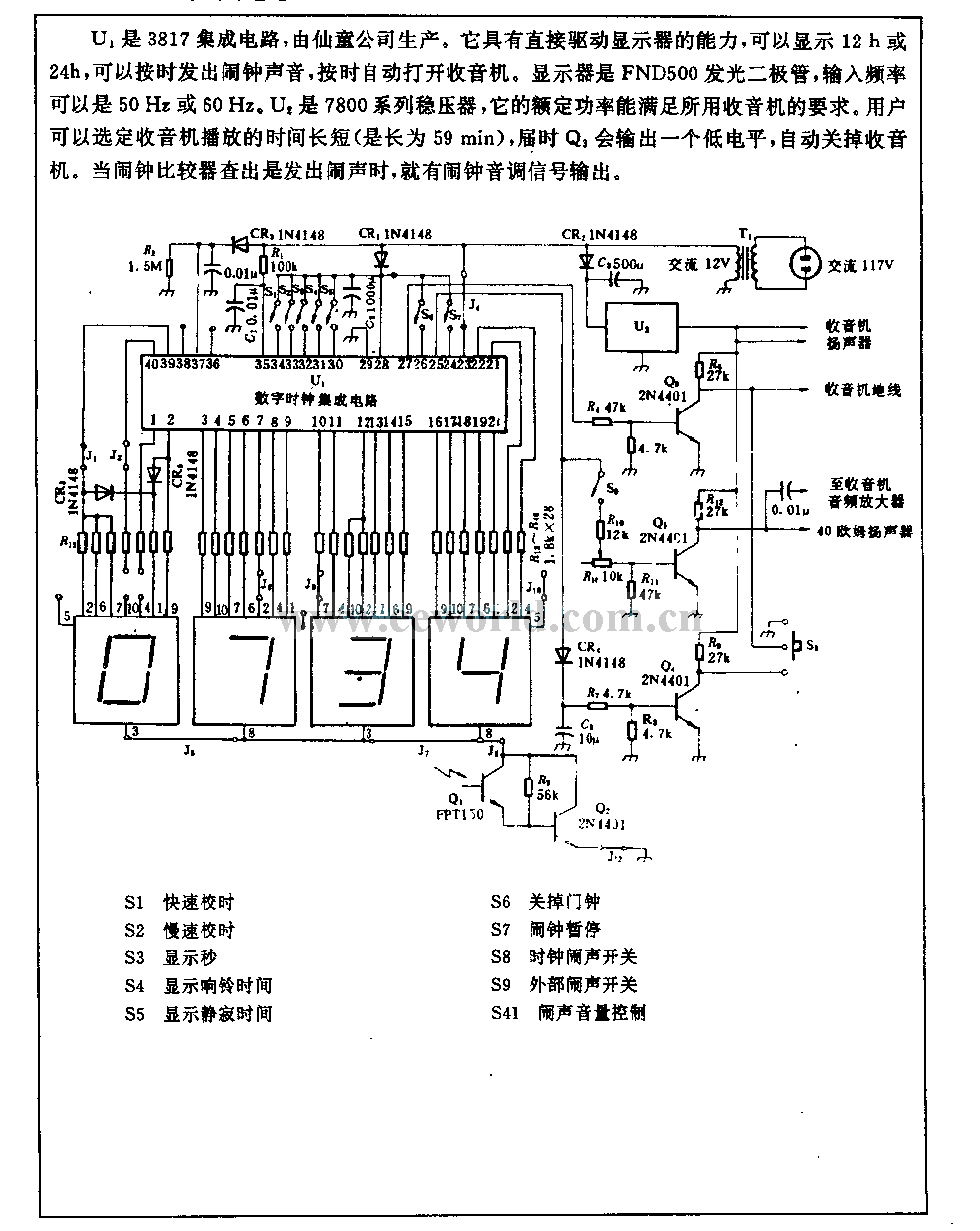
Digital Voltmeter
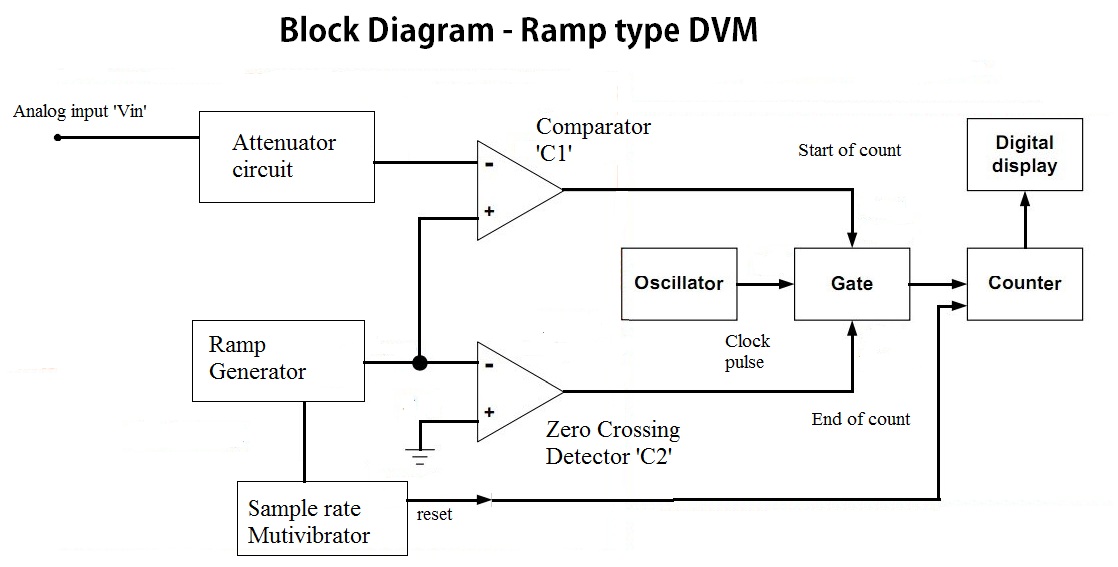
In the voltage-to-time conversion section, the analog input voltage is directed to the attenuation circuit. The attenuated signal is compared with the ramp signal generated by the ramp generator, as indicated in the block diagram, through the input comparator C1. Additionally, the ramp signal produced is compared to 0V via a zero-crossing detector C2. A sample rate multivibrator is connected to the ramp generator, serving to provide an initiating pulse for the ramp generator to commence the next ramp voltage for subsequent measurements. It also resets the counter before generating the next ramp voltage. In the time measurement section, a counter is triggered by a gating pulse. The inputs for the gating pulse include (i) the output of C1, (ii) the output of C2, and (iii) a clock pulse from the oscillator. The counter is reset after each successful time measurement completion by a control signal from the sample rate multivibrator. The produced count is displayed by connecting a suitable display device. Initially, the attenuated signal is compared with a negative-going ramp signal generated by the ramp generator. When the ramp voltage coincides with the input signal, the output of C1 becomes low, marking this point as the coincidence point, which initiates the counting process (start of count). The counter continues to count until the ramp voltage decreases and crosses zero (0V), which is detected by the zero-crossing detector C2. The output of C2 becomes high, signaling the end of the counting process. The displayed count represents the number of clock pulses produced by the oscillator during the duration in which the ramp signal is less than the input signal and greater than 0V (i.e., |input signal| > ramp > 0V). This count provides the digital equivalent of the input analog voltage.
The voltage-to-time conversion circuit is designed to accurately translate an analog voltage into a corresponding digital count, which represents the voltage level. The attenuation circuit serves to scale down the input voltage to a manageable level suitable for comparison with the ramp signal. The ramp generator produces a linear voltage ramp that increases over time, allowing for a straightforward comparison with the attenuated input signal.
The comparator C1 plays a crucial role in determining when the ramp voltage matches the input voltage. When the input voltage exceeds the ramp voltage, the output of C1 transitions low, signaling the start of the counting process. This transition is critical for timing applications where precise measurements of voltage levels are required.
The zero-crossing detector C2 is essential for identifying when the ramp voltage has returned to zero. This detection allows the system to know when to stop counting, ensuring that the count reflects only the duration in which the ramp voltage was less than the input voltage. The gating pulse, which is generated from the outputs of C1 and C2 along with the oscillator clock pulse, synchronizes the counting process, ensuring that counts are only registered during valid measurement intervals.
Finally, the display device connected to the counter provides a visual representation of the measured count, which corresponds to the input analog voltage. This conversion process is particularly useful in applications where analog signals need to be processed in digital systems, facilitating easier manipulation and analysis of the data. The entire system operates in a controlled manner, ensuring accuracy and reliability in the conversion of analog voltages to digital counts.In the voltage to time conversion section, the analog input voltage is fed to the attenuation circuit. The attenuated signal is compared with the the ramp signal generated by the ramp generator given in the block diagram by the input comparator `C1`.
Similarly, The ramp signal generated is compared with 0V via a zero-crossing detector `C2`. A sample rate multivibrator is connected to the ramp generator whose purpose is to provide an initiating pulse for the ramp generator to start the next ramp voltage for the next measurement. It is also used to reset the counter before generating the next ramp voltage. In the time measurement section, there is counter which is triggered by a gating pulse. The inputs of the gating pulse are (i) Output of `C1` (ii) Output of `C2` (iii) Clock pulse from the oscillator.
The counter is reset after each successful completion of time measurement by a control signal from the sample rate multivibrator. The count produced is displayed by connecting suitable display device. Initially, the attenuated signal is compared with a negative going ramp signal generated by the ramp generator.
When the ramp voltage coincides with the input signal, the output of `C1` becomes low. This point is called coincidence point. This initiates the counting process ( start of count ). The counter continues to count until the ramp voltage reduces and crosses zero (0V). This is detected by zero crossing detector `C2`. The output of `C2` becomes high which ends the counting process (end of count). The count displayed is the count of number of clock pulses produced by the oscillator during the time in which the ramp signal is less than the input signal and greater than 0V (ie) |input signal| > ramp > 0V. This count gives the digital equivalent of input analog voltage. 🔗 External reference
The voltage-to-time conversion circuit is designed to accurately translate an analog voltage into a corresponding digital count, which represents the voltage level. The attenuation circuit serves to scale down the input voltage to a manageable level suitable for comparison with the ramp signal. The ramp generator produces a linear voltage ramp that increases over time, allowing for a straightforward comparison with the attenuated input signal.
The comparator C1 plays a crucial role in determining when the ramp voltage matches the input voltage. When the input voltage exceeds the ramp voltage, the output of C1 transitions low, signaling the start of the counting process. This transition is critical for timing applications where precise measurements of voltage levels are required.
The zero-crossing detector C2 is essential for identifying when the ramp voltage has returned to zero. This detection allows the system to know when to stop counting, ensuring that the count reflects only the duration in which the ramp voltage was less than the input voltage. The gating pulse, which is generated from the outputs of C1 and C2 along with the oscillator clock pulse, synchronizes the counting process, ensuring that counts are only registered during valid measurement intervals.
Finally, the display device connected to the counter provides a visual representation of the measured count, which corresponds to the input analog voltage. This conversion process is particularly useful in applications where analog signals need to be processed in digital systems, facilitating easier manipulation and analysis of the data. The entire system operates in a controlled manner, ensuring accuracy and reliability in the conversion of analog voltages to digital counts.In the voltage to time conversion section, the analog input voltage is fed to the attenuation circuit. The attenuated signal is compared with the the ramp signal generated by the ramp generator given in the block diagram by the input comparator `C1`.
Similarly, The ramp signal generated is compared with 0V via a zero-crossing detector `C2`. A sample rate multivibrator is connected to the ramp generator whose purpose is to provide an initiating pulse for the ramp generator to start the next ramp voltage for the next measurement. It is also used to reset the counter before generating the next ramp voltage. In the time measurement section, there is counter which is triggered by a gating pulse. The inputs of the gating pulse are (i) Output of `C1` (ii) Output of `C2` (iii) Clock pulse from the oscillator.
The counter is reset after each successful completion of time measurement by a control signal from the sample rate multivibrator. The count produced is displayed by connecting suitable display device. Initially, the attenuated signal is compared with a negative going ramp signal generated by the ramp generator.
When the ramp voltage coincides with the input signal, the output of `C1` becomes low. This point is called coincidence point. This initiates the counting process ( start of count ). The counter continues to count until the ramp voltage reduces and crosses zero (0V). This is detected by zero crossing detector `C2`. The output of `C2` becomes high which ends the counting process (end of count). The count displayed is the count of number of clock pulses produced by the oscillator during the time in which the ramp signal is less than the input signal and greater than 0V (ie) |input signal| > ramp > 0V. This count gives the digital equivalent of input analog voltage. 🔗 External reference
